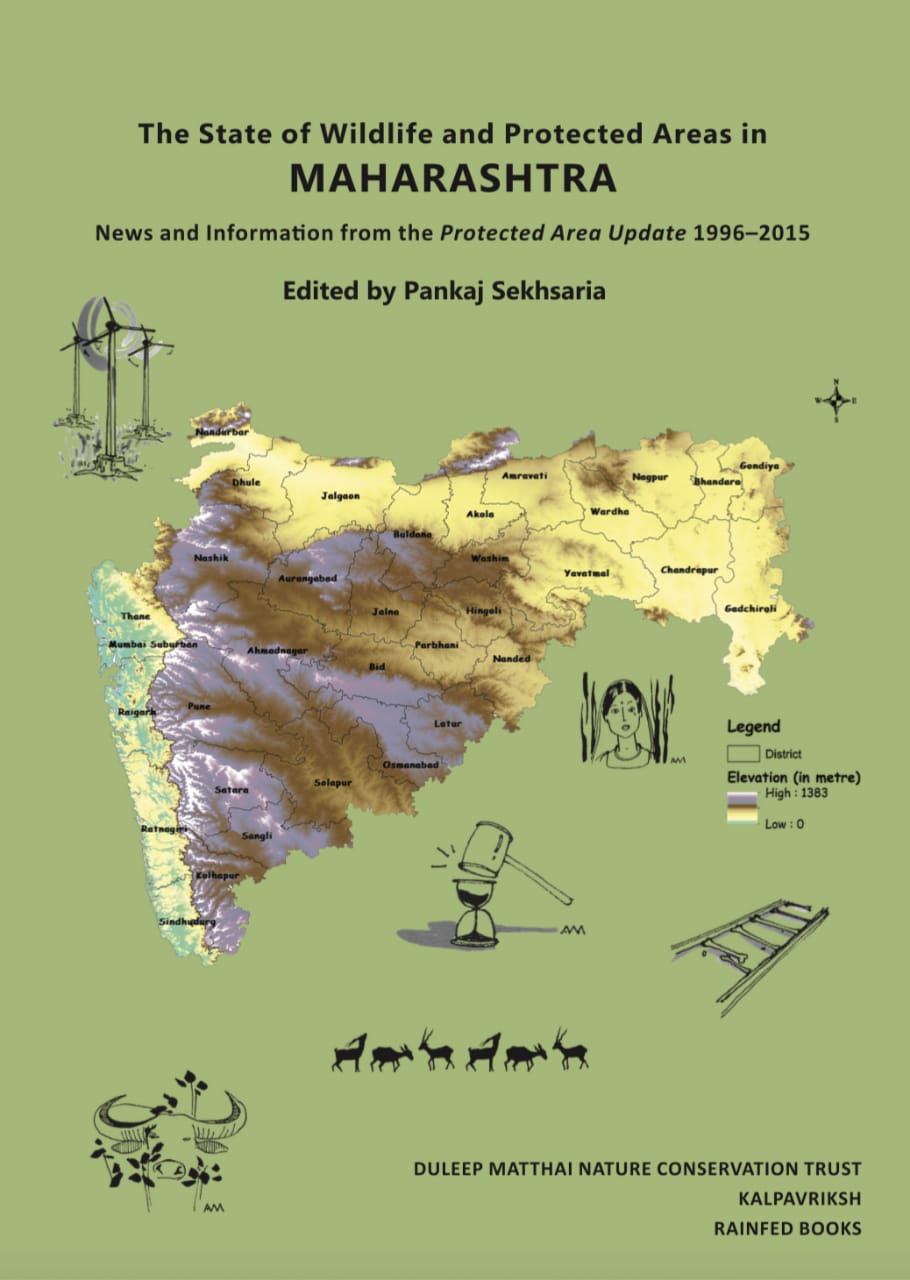Book review
‘The state of Wildlife and Protected areas in Maharashtra – News and information from the PA update: 1996-2015’.
Edited by: Pankaj Sekhsaria
Publishers: Duleep Matthai Nature Conservation Trust, Kalpavriksh, and Rainfed Books, 2019
Price: INR 400/-
Reviewed by: Santosh Shintre
Nature conservation is perhaps one of the more successful cultural movements in the history of humans, and has led to the setting aside of significant areas of the planet for nature. Presently, close to 15% of the Earth’s land and 2-5.7% of its oceans are reserved as national parks and other protected areas. If not entirely inviolate, these spaces are at least restricted for human use and development. Marine protected areas have increased by almost 300% in the last decade across the world.
As on July 2019, India had a total of 870 protected areas (PA), which amounts to 5.02% of India’s total land mass. Notwithstanding the fact that many of them are shrinking, fragmenting habitats with insidious habitat loss, at least these areas have varying degrees of legal protection.
India’s PAs have always been riddled with site specific problems: illegal grazing by millions of cattle, conflicts about relocation of people who reside in these areas or the recent spate of infrastructural development projects cutting through them.
The book under review thus comes at an appropriate time. Methodical and comprehensive, ‘The state of Wildlife and Protected areas in Maharashtra’, is a compilation of 20 years of news in the media about 42 protected areas in Maharashtra.
The book presents a consolidated account of the developments in the PA network in Maharashtra over two decades. It follows news items about any PA. We can see what happened month after month, year after year; what developments recurred at what periodicity; what were the issues that were important and what was done about them. It provides an important glimpse into the contemporary history of many places marked on the map as a protected area.
Protected Area Update (PAU), a bimonthly, small periodical offering a single point compilation of news relating to PAs in India has been published for the last 25 years. It is this periodical that has provided the basic material for all the analysis presented in this book. In these 25 years, PAU has carried around 7000 stories and news reports about India’s PAs.
But this book is not a mere chronological compilation. The volume is divided into three sections, which prove complementary to each other.
Section 1 contains nearly 300 news items/reports on PAs in Maharashtra, that PAU has carried from 1996-2015. Section 2 seeks to complement this barebones news-reporting by providing analysis and perspective on a variety of issues. And these are not just restricted to PAs but areas outside them too, all of it relevant to conservation and related policies. This section deserves praise, and demands a critical introspection of media attitudes towards this important but neglected subject. It also offers an insightful critique of the implementation of the Forest rights Act in two of Maharashtra’s most prominent tiger reserves. What’s more, it takes us into one of the least understood ecosystems of Maharashtra – the rocky plateaus. Lastly, the section includes vignettes of lesser known community-conserved areas (CCAs) along with a brief policy prescription of the measures needed to recognize and conserve them. A paper in this section by Reshma Jathar deserves special mention because it covers a subject hitherto unexplored and not analysed: Coverage of Conservation and Wildlife in Marathi Print Media – A practitioner’s perspective.
The author, while railing at the wrongs of media reporting, also offers some possible solutions to a sorry situation, which, unfortunately, has not improved much even five years after it was written. The paper succinctly summarizes the lackadaisical and prejudiced attitude of senior editors of Marathi print media. Their lack of understanding of, and apathy towards, environmental issues is, in this reviewer’s opinion, unfathomable.
This topic extends itself on a national level with another important paper in this section. Titled Media Reporting on Protected areas in Maharashtra: A thematic analysis, it is jointly authored by Trupthi Narayan and Pankaj Sekhsaria. It offers readers specific observations of flaws in reportage by English dailies. 39 such themes are reported in this extremely credible paper. It has a right use of graphics, too, but its last sentence, with 71 words, could surely have been broken down for better readability.
The paper on rocky plateaus by Aparna Watve is also extremely thought provoking. These plateaus have 188 endemic plant species, as reported by 2013, out of which 50 are threatened. The way the author describes these fragile yet resilient plant ecosystems is admirable.
The third section has a full issue of PAU printed just to give an idea of what this newsletter is and how it covers Pan-India PAs.
Editor Pankaj Sekhsaria deserves all praise for his conceptualization of such volumes (there is a similar one on PAs of North East India), and the structured resources created from such a massive effort. All in all, this book is a compulsory read for all who are studying or reporting about nature and conservation.
Copies of the book can be ordered at a 20% discount from psekhsaria at gmail dot com.


 CI is a non-profit, non-commercial portal that aims to facilitate wildlife and nature conservation by providing reliable information and the tools needed to campaign effectively.
CI is a non-profit, non-commercial portal that aims to facilitate wildlife and nature conservation by providing reliable information and the tools needed to campaign effectively.